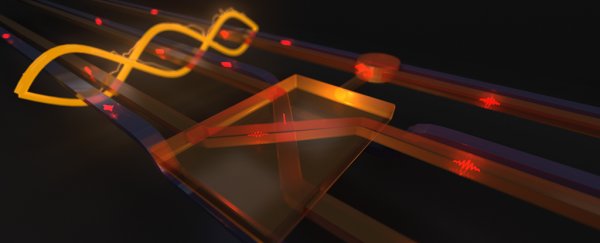The journey towards fully realised quantum computing hasn't been easy, and despite what Google says, we're not there yet. But with every tiny part we take from current computers and convert into a quantum-compatible counterpart, we're getting closer.
And now Australian researchers have reported building the first ever quantum Fredkin gate - a type of logic gate thought to be the key to quantum computing - that can operate on photonic qubits rather than regular bits.
As Mary-Ann Russon explains for the International Business Times, the Fredkin gate (also known as a CSWAP gate) is a type of reversible circuit that that swaps three inputs onto three outputs. "So if the first of the three bits is 1, then the last two bits are swapped from either 0 to 1 or 1 to 0, but if the first bit is already 0, then the last two bits won't be swapped," says Russon.
That process, which sounds fairly simple, is crucial to being able to build a real, functional quantum computer, and until now, scientists have struggled to build a Fredkin gate that works with quantum bits (qubits), not just regular bits.
Rather than using electrical circuits, quantum computing uses qubits to represent 0s and 1s. These qubit particles - magnetically suspended in an extremely cold environment - can be in the state of 0, 1, or both at the same time, which means the computing power at our disposal would increase exponentially.
But things can get so complicated when we consider just how far that potential can go, scientists are already arguing over what constitutes an actual quantum computer.
Google's D-Wave Systems is already selling what it calls quantum computers, but despite some promising experiments, not everyone is convinced these are true quantum computers - or at least not ones that are capable of producing the maximum processing power that quantum computing is expected to deliver.
And that brings us back to the scientists working in Australia. The researchers from the University of Queensland and Griffith University say that by simplifying a complex quantum logic operation through a Fredkin gate, they've removed one of the key obstacles between us and true quantum computing power.
Usually, the Fredkin gate requires the integration of five logic operations, but the researchers were able to use the quantum entanglement of photons (particles of light) to implement the same operation directly. This means small- and medium-scale quantum computers are now more feasible than ever, and it should help in the development of secure quantum communication protocols too.
"Similar to building a huge wall out lots of small bricks, large quantum circuits require very many logic gates to function. However, if larger bricks are used the same wall could be built with far fewer bricks," said Raj Patel from Griffith's Centre for Quantum Dynamics.
"What is exciting about our scheme is that it is not limited to just controlling whether qubits are swapped, but can be applied to a variety of different operations opening up ways to control larger circuits efficiently," adds Geoff Pryde, the project's chief investigator. "This could unleash applications that have so far been out of reach."
The team's work has been published in the journal Science Advances.
